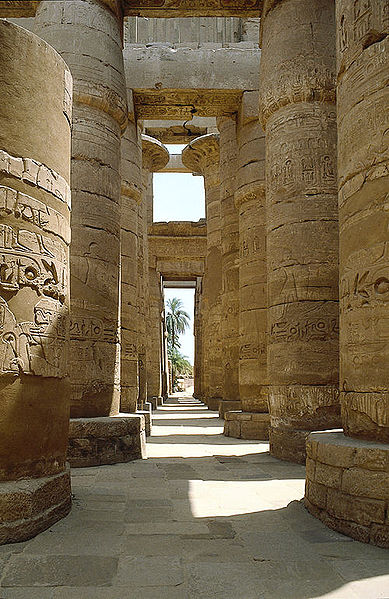Ancient Egyptian architecture
Ancient Egyptian architecture is the architecture of ancient Egypt, one of the most influential civilizations throughout
history, which developed a vast array of diverse structures and great
architectural monuments along the Nile,
among the largest and most famous of which are the Great Pyramid of
Giza and the Great Sphinx of
Giza.
 The well preserved Temple of Horus at Edfu is
an example of Egyptian architecture and architectural sculpture.
The well preserved Temple of Horus at Edfu is
an example of Egyptian architecture and architectural sculpture.
Characteristics Drawings of the types of the architectural capitals
specific for the Ancient Egyptian civilization.
Drawings of the types of the architectural capitals
specific for the Ancient Egyptian civilization.
Ancient Egyptian houses were made out of mud collected
from the Nile river. It was placed in molds and left to dry in the hot sun to
harden for use in construction.
The Giza pyramid complex
 The Pyramids of Giza
The Pyramids of Giza
The pyramids, which were built in the Fourth Dynasty,
testify to the power of the pharaonic religion and state. They were built to
serve both as grave sites and also as a way to make their names last forever.
The size and simple design show the high skill level of Egyptian design and
engineering on a large scale. The Great Pyramid of Giza, which was
probably completed c. 2580 BC, is the oldest and largest of the pyramids, and
is the only surviving monument of the Seven Wonders of the Ancient World.
Karnak
 The hypostyle hall of Karnak Temple
The hypostyle hall of Karnak Temple
The key difference between Karnak and most of the other
temples and sites in Egypt is the length of time over which it was developed
and used. Construction work began in the 16th century BC. Approximately 30
pharaohs contributed to the buildings, enabling it to reach a size, complexity
and diversity not seen elsewhere. Few of the individual features of Karnak are unique,
but the size and number of features is overwhelming.
Luxor Temple
 Luxor Temple, from the east bank of the Nile
Luxor Temple, from the east bank of the Nile
The temple proper begins with the 24 metre (79 ft)
high First Pylon, built by Ramesses II. The pylon was decorated with
scenes of Ramesses's military triumphs (particularly the Battle of
Qadesh); later pharaohs, particularly those of the Nubian and Ethiopian dynasties,
also recorded their victories there. This main entrance to the temple complex
was originally flanked by six colossal statues of Ramesses – four seated,
and two standing – but only two (both seated) have survived.
Please notice that i`m trying to compress the amount of
words written and be more general, for more articles about ANCIENT EGYPTIAN
ARCHITECTURE please see the rest of articles under the same title and wait for
another articles I am writing.






.jpg)
































